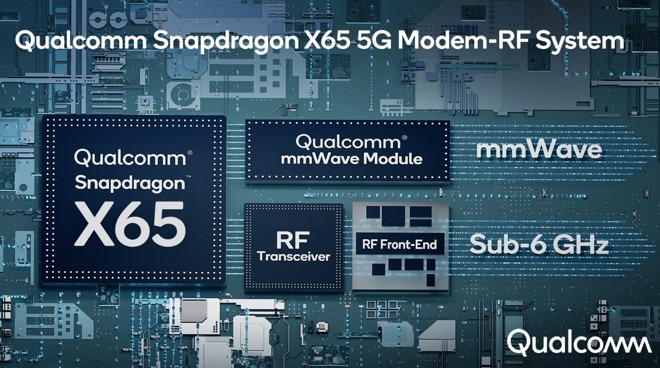Qualcomm teases Snapdragon X65 5G 10Gbps modem for 2022 iPhone
Qualcomm has introduced its latest 5G modem, the Snapdragon X65, a chip that could help provide Apple's 2022 iPhone with cellular speeds of up to 10Gbps.

In its latest annual modem release, the Snapdragon X65 is a 5G-compatable modem that follows on from the previous model, the Snapdragon X60. The fourth-generation modem is claimed to be the first to reach 10-gigabit 5G connection speeds, which can potentially mean faster downloads to consumers if carrier conditions are favorable.
The modem is also the first 3GPP Release 16 modem-RF system, supporting the latest specification from 3GPP that offers various improvements to cellular connectivity. This includes specifications relating to power consumption and MIMO usage.
The modem is said to have an upgradable architecture to add software features and capabilities as part of the 3GPP Release 16 rollout. This can increase speeds further or introduce entirely new features.
The module is engineered to pair with Qualcomm's QTM545 mmWave antenna module pairs, which can support a higher transmit power.
There is also the bold claim of it having the world's first "AI antenna tuning technology," which could further enhance connectivity. By using AI, Qualcomm claims it can detect hand grips with 30% more accuracy, allowing the modem to switch antennas for better signal.
Qualcomm's 5G PowerSave 2.0 is also included, using 3GPP Release 16 power-saving initiatives such as Connected-Mode Wake-Up Signal. It also has Smart Transmit 2.0, a "system-level technology" to increase upload data speeds and enhance coverage, while remaining within RF emissions requirements.
Qualcomm has started to provide samples of the modem to vendors, with a view to its inclusion in devices staring in late 2021.
Apple is almost certain to use the modem in a future iPhone, but its schedule for production and legal filings discussing the Qualcomm release timeline make it certain that it will appear in the 2022 model, rather than the 2021 releases. The X60 is anticipated to appear in the upcoming "iPhone 13" models.
The chip producer has enjoyed high sales due to Apple's iPhone, which it supplies Apple as part of a settlement of billion-dollar legal battles. However, Apple is known to be working on its own modem designs, which could appear in future iPhone models down the road.

In its latest annual modem release, the Snapdragon X65 is a 5G-compatable modem that follows on from the previous model, the Snapdragon X60. The fourth-generation modem is claimed to be the first to reach 10-gigabit 5G connection speeds, which can potentially mean faster downloads to consumers if carrier conditions are favorable.
The modem is also the first 3GPP Release 16 modem-RF system, supporting the latest specification from 3GPP that offers various improvements to cellular connectivity. This includes specifications relating to power consumption and MIMO usage.
The modem is said to have an upgradable architecture to add software features and capabilities as part of the 3GPP Release 16 rollout. This can increase speeds further or introduce entirely new features.
The module is engineered to pair with Qualcomm's QTM545 mmWave antenna module pairs, which can support a higher transmit power.
There is also the bold claim of it having the world's first "AI antenna tuning technology," which could further enhance connectivity. By using AI, Qualcomm claims it can detect hand grips with 30% more accuracy, allowing the modem to switch antennas for better signal.
Qualcomm's 5G PowerSave 2.0 is also included, using 3GPP Release 16 power-saving initiatives such as Connected-Mode Wake-Up Signal. It also has Smart Transmit 2.0, a "system-level technology" to increase upload data speeds and enhance coverage, while remaining within RF emissions requirements.
Qualcomm has started to provide samples of the modem to vendors, with a view to its inclusion in devices staring in late 2021.
Apple is almost certain to use the modem in a future iPhone, but its schedule for production and legal filings discussing the Qualcomm release timeline make it certain that it will appear in the 2022 model, rather than the 2021 releases. The X60 is anticipated to appear in the upcoming "iPhone 13" models.
The chip producer has enjoyed high sales due to Apple's iPhone, which it supplies Apple as part of a settlement of billion-dollar legal battles. However, Apple is known to be working on its own modem designs, which could appear in future iPhone models down the road.

Comments
What I care about is:
- power efficiency. I don’t to be wasting power looking for a useless 5G signal that still doesn’t exist.
- the ability to get a good connection with a weak signal. There are large areas of the U.S. where you get 2 bars max, including indoors in metropolitan areas with ‘excellent’ coverage. I’d rather have a modem and antenna that performs well in these circumstances than one that can deplete my data plan in 5 minutes ‘if conditions are right.’
As with the previous-generation Snapdragon X60, the X65 can aggregate data from mmWave and sub-6GHz bands simultaneously to achieve an optimal combination of high-speed and low-latency coverage. The modem is paired with Qualcomm's new fourth-generation mmWave antenna module for extended mmWave coverage and power efficiency. " - Macrumors
The difference it makes — drumroll please — is that it's "not just about you", but about the network, and servicing all users. The sooner your device can connet, download and disconnect, the more network bandwidth is freed up for other users, or other apps on your device. Better for everyone.